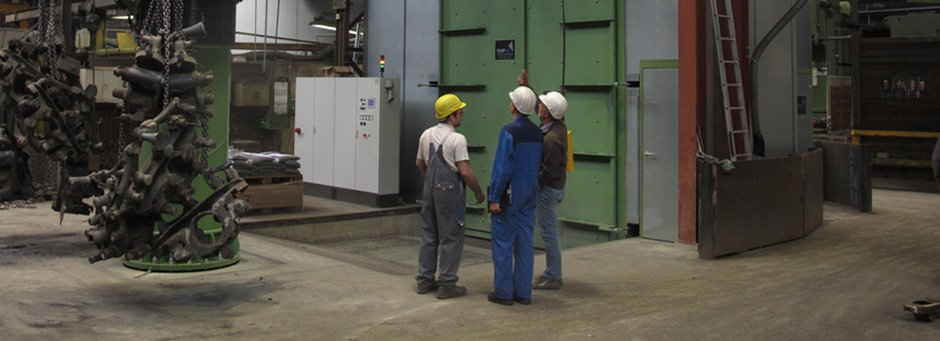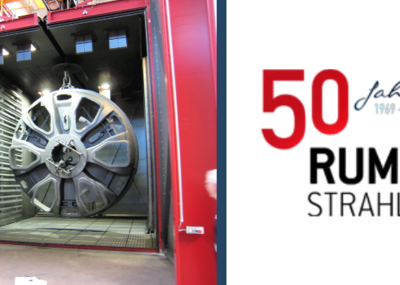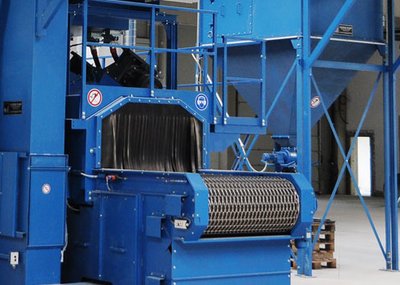In the foundry Reinhard Tweer GmbH in Bielefeld-Sennestadt a RUMP overhead Monorail system was put in operation in foundry compatible design. It came as a replacement for the outdated smaller predecessor machine, which was displayed at the 1989 GIFA exhibition in Dusseldorf, because of its extraordinary handling technology.
The blasting chamber of the system is entirely made of austenitic manganese steel and is stabilized with a profile steel frame, which also forms the supporting structure for the above chamber components with an extending special hook-conveyor system. In addition, loosely hanging and easily replaceable linings, made of reinforced high-manganese steel sheet panels are located inside the chamber, opposite to the Turbines against the direction of blasting.
The bottom cover protects the under-built blast medium recirculating system from direct exposure to blast. The work pieces are transported by means of an overhead hook-transport system located at the front of the blasting chamber through a double-wing pneumatically operated door made of manganese steel fitted with an emergency switch on the inside. The system is equipped with four turbines with mechanical pre-acceleration and a drive power of 30 kW per Turbine. These are mounted on the blasting chamber along the side wall, in such a way that an optimum spray pattern is made to reach the hidden points of the work pieces and also homogeneous along the whole surface.
The abrasive sand mixture is collected from the blasting chamber and transported back to the Hooper by means of vibrating conveyer and bucket elevator. Huge pieces of contaminants such as nails and sand lumps that are removed from the work piece are screened by the bottom plates and discharged into a residual container placed below. The bucket elevator pit consists of highly wear-resistant manganese steel and includes the rotating rubber belt with fabric inlays and patch scoop buckets with reinforced scoop edge. The abrasive sand mixture from the buck elevator enters in to a two-stage magnetic separator. In the first stage the ferritic abrasive is separated by a magnetic roller from the moulding sand and runs through an air classifier for the separation of small particulate impurities, residual fractions and sand. The secreted blasting agent falls over a second magnetic roller repeating the process and the cleaned blasting material is then dropped in to the storage hopper and is fed from there to Turbine by a controlled pneumatic actuation.
The Turbines used are reliable "TSMV" Turbines with belt drive. The housing of the turbine is made entirely of laser cut manganese steel plates. The turbine consists of an impeller and control cage made of hardened tool steel that directs the flow direction. The blower is equipped with two side discs and eight straight throwing blades made of highly wear-resistant special steel and has an outer diameter of 500 mm. The blast wheels operate on the principle of mechanical pre-acceleration and are equipped with a centrally disposing distributor wheel. The distributor sleeve can be adjusted to achieve optimal blast beam. The blasting medium from the blades are guided between the two side discs. It is powered by a standard three-phase motor with a power of 30 kW. The initial velocity of the blast wheels is about 80 m/s at an engine rated speed of 1500 rpm and a Turbine speed of 2500 rpm and the blasting medium flow rate per wheel of about 350 kg per minute. The blasting medium consumption per wheel is about 6 to 8 kg per hour depending on the range of parts and finish.
The blasting medium is a mixture of spherical cast steel with a diameter of about 1.5 to 2.5 mm and a hardness of about 48 to 51 HRC. The blasting medium is directed specifically to the surface of the work pieces in an optimal spray pattern. The wear of spinning wheel and machine-internal lining is thereby greatly reduced.
The work piece transportation is done by traversing it by the above bridge crane system. For this purpose, a proven concept has been used in which up to 10-ton batches of work pieces are attached to a stand, in front of the blast chamber with a loop on a three-armed load transfer buffer system and a 120 ° pivot located above the chamber trolley with crane chassis and a load hook is passed. The carriage traverses to the starting position automatically to the front of the cabin. The temperature of the radiant workpieces may occasionally be up to 800 ° C after the heat treatment. After the start command from the operator, the chamber door closes and the shot blast treatment with the pre-set parameters begins. The rotating load hook is equipped with a chain arranged above the chamber ceiling, which is engaged to a rotator during the blasting process. With this trolley the hook moves with the suspended load in succession in three blasting positions and is rotated about the hook shaft with a frequency controlled electro-pneumatic pivoting rotator to achieve full spray pattern coverage so that the undercuts in work piece are reached. After the treatment, the doors open and the complete blasted cast work pieces are handed over to the three-armed position swing column in front of the blast chamber, with which the changing of work piece is performed.
The dust extraction of the blasting chamber and the air classifier is done by the central filtering system with a total air flow of 15 000 m3 / h.
The blasting machine and the conveyor system are controlled via a freely programmable control system, which allows a safe and trouble-free operation and provides various blasting programs. Individual parameters can be varied over a touch panel with plain text display. The electrical power consumption of the blasting system is approximately 145 kW.
The precise separation of sand and blasting medium prevents wear and also reduced high loss of blasting medium at the outlet. The two-stage magnetic separation makes it possible, to recycle a large part of the deposited moulding sand, which is then, if necessary, supplied via a pneumatic station downstream of the sand reclamation.
Author:
Heinz Neise
RUMP STRAHLANLAGEN GmbH & Co KG, Salzkotten
Partner
Foundry Corporate News
Topic Discharging, Decoring, Fettling, Finishing
Euroguss 2016
RUMP-blasting machine for hand-made castings
Reading time: min
[7]





